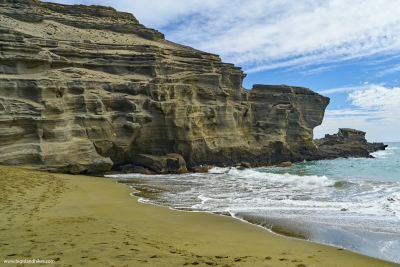
Papakolea Beach in Hawaii is one of only four green sand beaches in the world situated beneath Mauna Loa, the world’s largest volcano. The volcano’s eruptions formed a massive cinder cone (conical hill of volcanic debris) that circled around to create a small bay. The eruptions brought tons of minerals to the surface, including an abundance of olivine, so much so that much of the cone was made from the silicate mineral. As the cone eroded, most of the ash and glass from the eruptions were washed out to sea. But the denser chunks of olivine survived causing the beach to turn a rare green colour.
Papakolea beach is a geologic oddity among few in the world. It means ‘plover flats,’ after the Pacific golden plover. This hike travels to a green sand beach located in a bay cut into a side of Pu?u Mahana, a cinder cone that erupted about 50,000 years ago. The green sand is created by a common mineral in Big Island lava called olivine, which stays deposited on this beach because it is heavier than the other components of the lava.
Pu’u Mahana last erupted around 49,000 years ago. Since then, the cinder cone has partially collapsed and has been eroded by the ocean. The cinder cone is rich in olivine, a silicate mineral containing iron and magnesium. Olivine is a common mineral component of Hawaiian lavas and one of the first crystals to form as magma cools. Olivine is locally known as the ‘Hawaiian diamond’, and is notably found in O?ahu’s famous Diamond Head volcano.
Picture Credit : Google




